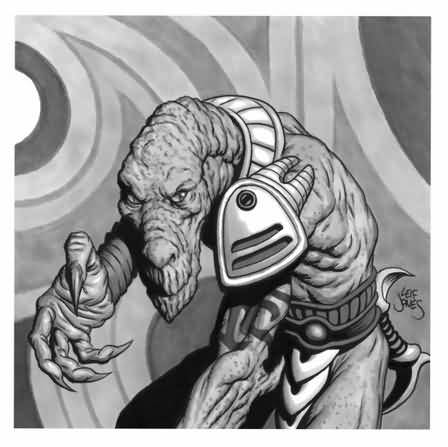8. SENSORY ORGANS
So far we have formulated the picture of an intelligent ET with a body much like our own. Its sensory organs, however, show characteristics that are somewhat different, though not greatly.
Sense organs would largely depend on the characteristics of the aliens planetary environment and the illumination provided by the local sun.
More than two eyes is rare in land creatures — the spider possesses multiple eyes, but they are of doubtful sensitivity, and would confuse a large hunting creature. Stereoscopic vision near to the brain and high on the body is the most suitable. Binaural hearing would seem the most logical. This is required for location bearing — and thus the ET requires just two ears. Again these would be on the head. Only one mouth is needed with the smell sensor close to it and taste sensors inside it. The smell sensor can be used for breathing, whilst the mouth is occupied with eating and drinking.
Additional sensory devices such as bat like acoustic ranging systems or infrared sensors similar to those possessed by the rattlesnake, are possible. But as Bieri points out, the imply a corresponding reduction of vision in the normal sun illuminated spectrum. As we have established above that carbon life probably only develops on planets with suns much like our own we can assume that the visual spectrum would be similar to that on Earth for the alien ET.
Although, therefore, the sensors of the ET are similar to our own, the placement on the head and their form might be quite different. Odd shaped heads are likely, different ear shapes and sizes most probable and eye size and colour would be different.

9. THE LIKELY ET APPEARANCE
The argument presented above gives backing to the anthropormorphic view of the intelligent ET — that is that the creature would be basically humanoid. But this only a starting point. What would the intelligent ET look like in detail?
This question is, of course, even more difficult to contemplate than speculating on the ET’s likely basic form. However, here are a number of possible variables to consider:
1. SIZE AND BUILD — The height and build of the alien has often been suggested as being related to the gravity on the creature’s palnet of origin.
A planet slightly larger than Earth, witha subsequently higher gravity would result in the alien being squatter, with heavy bones and a powerful physique — in other words, something like a gorilla. On the other hand, a lower gravity planet would result in taller, more spindly aliens. This argument is a little simplistic in its conclusion and does not explain the wide range in the sizes of Earth creatures — for example, why is there such a large variation in the size and build of the apes, all of which are fairly clever animals?
It seems probable that one can draw parameters about the ET’s size, the likely range being between the smallest of the human races (the pygmy) at about 4 1/2 feet tall and the upper limit being around 7 1/2 feet tall. If the alien is very much heavier than man, he would have problems with running for long distances in pursuit of prey in his early development as a land predator and would require a very large supply of readily available food to maintain himself.
One interesting point about man is that we appear to be getting taller due to our evolution, our bodies are losing their broader muscles and our heads changing shape. It is more than likely that the humanoid intelligent alien also experiences this form of slow morphological evolution due to changes in dietary nutrition and life style. There is, of course, no guarantee tha the alien will meet man as we appear now. An intelligent alien basing his conception of what man looks like from previously discovered spacecraft message devices (such as those carried by Pioneers 10 and 11), or picked up TV images in, say, 50,000 years time, may be in for a surprise when he meets a hairless, chinless, towering egghead from Earth!
Equally interesting is the question of the differences between the male and the female of the intelligent aliens’ species. Would the two be quite different morphologically as in the case of homo sapiens, or would the two be virtually indistinguishable as with some creatures on Earth?
2. SKIN COLOUR — The wide variation in skin colour and tone with creatures on the Earth is enough to indicate the extreme range that could occur with the intelligent ET. Indeed, why would the ET have a smooth skin? It is possible that fur may cover the alien having been left behind after an evolution stemming from a bear like creature, for example. (indeed, it is interesting to wonder whether whiskers, or some sort of delicate sensory feelers may remain with an intelligent creature after it has begun to rel y on its hands).
3. FACIAL ARRANGEMENT — This, as already stated, is mainly constrained by the smell and taste sensors being close to the mouth and by the need for stereo vision and binaural hearing. Beyond this the facial arrangement possibilities would be reasonably wide.
4. NUMBER OF FINGERS/TOES — Again, variations could be wide although beyond ten fingers or toes on each hand or leg would seem excessive and difficult for the brain to coordinate. Less than four fingers on the hand would make basic technology difficult to manipulate.
5. INTERNAL CHARACTERISTICS –– The internal digestive, cardiovascular and pulmonary systems inside the intelligent ET would most likely be quite different and it is not possible to list all the variations within the confines of this article.
10. THE LIKELY REACTION
Our immediate impressions of the intelligent ET will be critical to how society later reacts to the contact. The theme of this article is that, because of the evolutionary demands to become intelligent and the probable similarity between Earth and the alien planet, the intelligent ET will be basically humanoid in form. Therefore, our reaction will most likely not be too extreme. Various questions, however, remain. For example, how far will the ET have evolved beyond the humanoid morphology? It is unlikely that prosthetics will change the basic form of the ET. In general, artificial limbs (and bionics) are intended to resemble those currently possessed.
The aliens’ view of good looks will be determined by the most perfect and healthy of its species. Consequently any artificial aids will be designed to blend with the pure form of the alien — contact lenses replacing glasses is a good example of this. It is difficult to imagine the advanced alien ever giving up its basic body appearance. Some writers have suggested that semi-immortality might be achieved by removing the brain from the failing body and installing it in a machine, thus creating the cyborg. If this is ever done it is likely that man would want the new machine body to resemble the original organic body shape. An even more radical idea is that once the alien has developed very high levels of knowledge and consciousness, the mind may even be li berated from the body. If this occurred we might never discover its original appearance.
A final question is to what degree will alien clothing and cosmetics mask the basic morphology? Fashions can enhance and emphasise body shapes in certain cases with our own current civilization — possibly the same will occur in the intelligent ET’s society. Hair styling, however, is an example of how sometimes fashion can seriously alter the shape of the body. Also, any spacesuit or breathing apparatus might appear unusual.
Unfortunately, only through the discovery of artifacts or through contact itself will we ever learn what the actual morphology of the alien may be. Indeed, the chances are that the first close encounter with an alien civilization will be via the radio telescope. Video pictures will in this situation have to suffice for many years in the place of face to face contact. It is the conclusion of this paper that these images of the intelligent ET will not shock us; they may surprise and intrigue us, but it is unlikely that mankind will find the alien fearful in physical appearance. Hopefully, the ET will feel the same way about us.
REFERENCES
1. R.N. Bracewell, “Life in the galaxy,” reprinted in INTERSTELLAR
COMMUNICATION, ed. A. Cameron (Benjamin, NY 1963).
2. Robert Bieri, “Humanoids on other planets?” AMERICAN SCIENTIST, LII
December, 1964
3. P.M. Molton, “Is anyone out there?” SPACEFLIGHT, 15,p.250, July, 1973
4. S.W.P. Steen in the review of Freudenthals “Lincos” language, BRITISH
JOURNAL OF THE PHILOSOPHY OF SCIENCE, 336, (1962)
5. D. Dooling, “Speculating on man’s neighbours,” SPACEFLIGHT, 17, p232,
(Juen, 1975)
6. N.J. Berrill, “Worlds without end,” Chapters 9 and 10
7. Roland Puccetti, “Persons: a study of possible moral agents in the
universe,” Macmillan, 1968
SOURCE: Journal of the British Interplanetary Society Vol 32, pp.99-102,1978 TITLE: THE PHYSICAL APPEARANCE OF INTELLIGENT ALIENS AUTHOR: N.J. SPALL Bearsted, Nr. Maidstone, Kent, England








